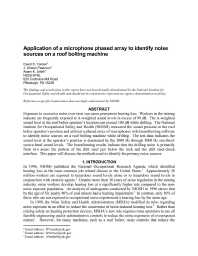Mining Publication: Application of a Microphone Phased Array to Identify Noise Sources on a Roof Bolting Machine
Original creation date: October 2007
Exposure to excessive noise over time can cause permanent hearing loss. Workers in the mining industry are frequently exposed to A-weighted sound levels in excess of 90 dB. The A-weighted sound level at the roof bolter operator's location can exceed 100 dB while drilling. The National Institute for Occupational Safety and Health (NIOSH) measured the sound pressure at the roof bolter operator's position and utilized a phased array of microphones with beamforming software to identify noise sources on a roof bolting machine while drilling. The test data indicates the sound level at the operator's position is dominated by the 2000 Hz through 5000 Hz one-third octave-band sound levels. The beamforming results indicate that the drilling noise is primarily from two areas: the portion of the drill steel just below the rock and the drill steel-chuck interface. This paper will discuss the methods used to identify the primary noise sources.
Authors: DS Yantek, JS Peterson, AK Smith
Conference Paper - October 2007
NIOSHTIC2 Number: 20032795
NOISE-CON 2007, Reno, Nevada, October 22-24, 2007. Burroughs C; Hambric S; Conlon S; Maling G, eds., Ames, IA: Institute of Noise Control Engineering of the USA, 2007; :1-12
See Also
- Cross-Sectional Survey of Noise Exposure in the Mining Industry
- Determination of Sound Exposures (DOSES): Software Manual and Implementation Guide
- International Noise Awareness Day
- Limestone Mining: Is It Noisy or Not?
- Noise and Hearing Protection: Development of Two Training Exercises for Drillers
- Noise Control in Underground Metal Mining
- Snapshot of Noise and Worker Exposures in Sand and Gravel Operations
- Technology News 536 - NIOSH Develops New Software to Analyze and Reduce Noise Exposure
- Water Well Safety Bits: Health And Safety Information For The Water Well Industry
- What Does a Hearing Loss Sound Like?
- Page last reviewed: 9/21/2012
- Page last updated: 9/21/2012
- Content source: National Institute for Occupational Safety and Health, Mining Program


 ShareCompartir
ShareCompartir
